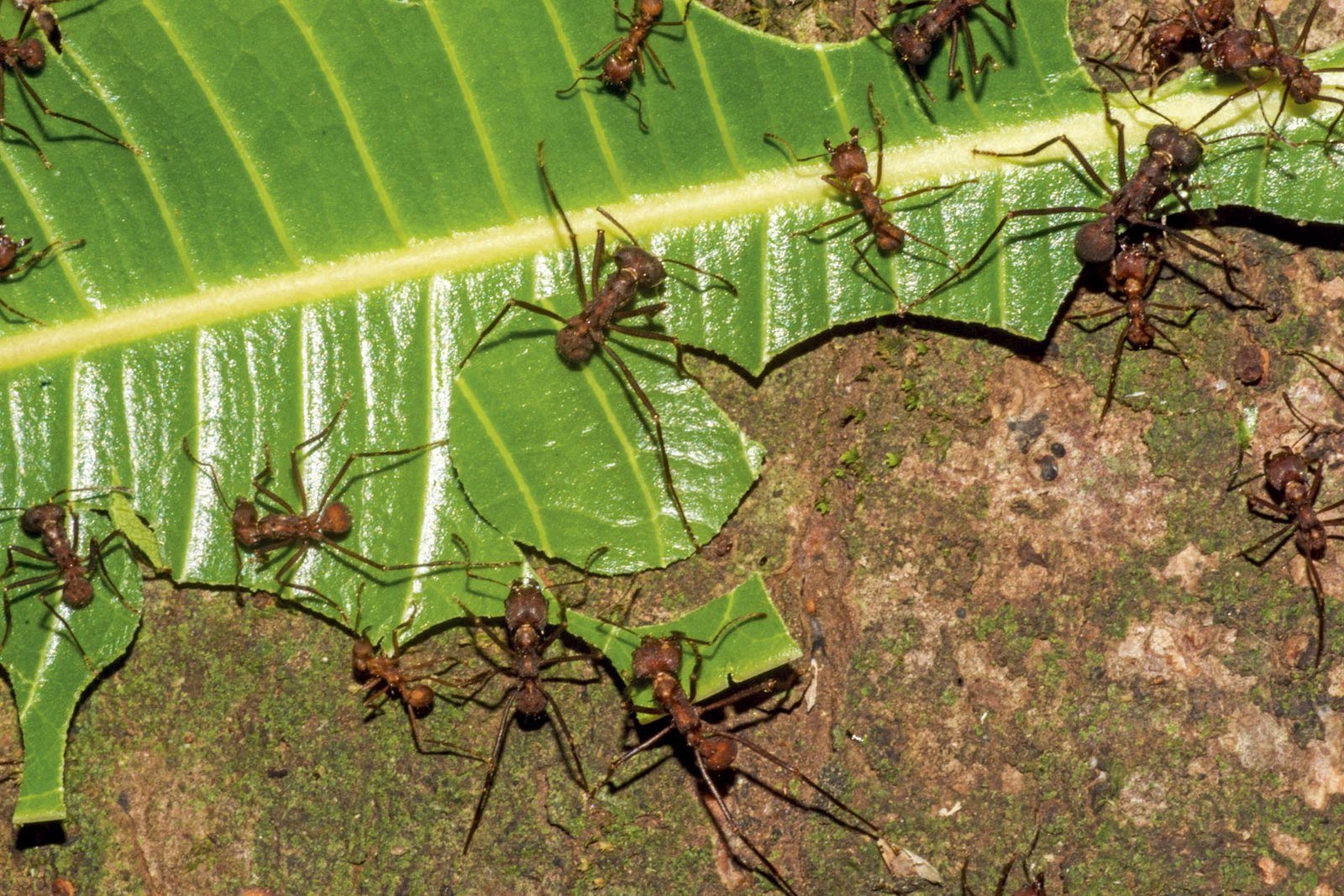
Medicinal Plants Herbs for the Herbalist
Text and photos: Javier A. Pinzón
In my childhood memories I see my grandmother enter my room with a steaming cup of peppermint tea. She’d bring it in whenever a stomachache kept me from going to school, and it seems to me now that, despite the pain, I rather enjoyed my grandmother’s pampering and the aroma that filled the whole house. Even today, no matter where I am, the scent brings to mind the loving hand that cradled my childhood.
She cured everything with herbal teas: ginger tea for nasal congestion or sore muscles and chamomile for headaches. Her home pharmacy was supplied with the “essential” plants grown in a small rooftop garden. They were plants she learned about from her grandmother, who learned about them from her own grandmother.
Years have passed and much water has gone under the bridge, but now, as a scientist, my belief in my grandmother’s knowledge grows increasingly stronger as I see pharmaceutical companies base their searches for active ingredients on the same traditional medicines she used. My attention was therefore drawn to the collection of medicinal herbs in the Bogotá Botanical Garden, where these notes were taken.
Achillea millefolium
 The genus Achillea was named in honor of Achilles, who, during the Trojan War, used the plant to stop bleeding among his soldiers. This herbaceous plant is also commonly called yarrow, milfoil, or bloodwort. With its many medicinal properties, it is used as an anti-inflammatory, to help heal bruises, as a hemostatic agent (to stop bleeding by constricting blood vessels and promote coagulation), as an antiseptic (to kill germs or prevent their growth), and as a tonic (to restore and strengthen the body).
The genus Achillea was named in honor of Achilles, who, during the Trojan War, used the plant to stop bleeding among his soldiers. This herbaceous plant is also commonly called yarrow, milfoil, or bloodwort. With its many medicinal properties, it is used as an anti-inflammatory, to help heal bruises, as a hemostatic agent (to stop bleeding by constricting blood vessels and promote coagulation), as an antiseptic (to kill germs or prevent their growth), and as a tonic (to restore and strengthen the body).
Taraxacum campylodes
Taraxacum (better known as dandelion) is a common flowering grass, which many consider a nuisance or “weed.” However, it has been used for centuries to cure and prevent disease as it helps to maintain proper functioning of the liver, fights acne and eczema, improves ocular health, and contributes to weight loss. These properties are due to the phenolic acids, inulin, and minerals contained in the herb, along with a number of other substances beneficial to the skin. During periods of scarcity, the dried root has been used as a substitute for chicory, which in turn is a substitute for coffee.
Tanacetum parthenium
 Commonly known as feverfew, this herbaceous, aromatic, and medicinal perennial belongs to the composite family. It reduces fever (as its name suggests) and relieves headaches, arthritis, and digestive problems. Its active ingredients include parthenolide and tanetin.
Commonly known as feverfew, this herbaceous, aromatic, and medicinal perennial belongs to the composite family. It reduces fever (as its name suggests) and relieves headaches, arthritis, and digestive problems. Its active ingredients include parthenolide and tanetin.
Verbascum thapsus
Popularly known as mullein, this member of the snapdragon family (Scrophulariaceae) is native to Europe, West Asia, Africa, North America, and the Himalayas. It grows on barren terrain, slopes, and dry grasslands. Roman women used the flower’s yellow pigment to lighten their hair. This plant is used as an expectorant to counter asthma and bronchitis and its mucolytic action helps people quit smoking when the herb is extracted by tincture or diluted in a homeopathic solution. The plant’s roots can be used to treat hemorrhoids.
Salvia officinalis
Sage is a herbaceous species of the Lamiaceae family. Its scientific name comes from the Latin salvare, meaning “to save.” Perhaps that’s why in México the plant is considered sacred. Its many medicinal properties make it a good antiperspirant, hypoglycemic treatment, emetic, stimulant, antispasmodic, astringent, and antiseptic. In traditional Austrian medicine it is administered as an infusion or chewed to treat respiratory and gastrointestinal diseases and mouth and skin ailments.
Symphytum officinale
 Commonly called comfrey, this plant stands out as one of the best traditional methods for healing wounds. Its name comes from the Latin consolida, which means “to consolidate” or “merge.” Ancient cultures gave it this name because they believed it helped knit broken bones and close wounds. This ability to promote healing and prevent bleeding comes from its high levels of allantoin, which in the plant’s tender roots can reach up to 1.5%. For this reason, comfrey often appears on the list of ingredients for many skincare products. Moreover, due to its high content of mucilage (up to 30%), it acts as a demulcent to relieve mucus-related irritation, inflammation, and pain.
Commonly called comfrey, this plant stands out as one of the best traditional methods for healing wounds. Its name comes from the Latin consolida, which means “to consolidate” or “merge.” Ancient cultures gave it this name because they believed it helped knit broken bones and close wounds. This ability to promote healing and prevent bleeding comes from its high levels of allantoin, which in the plant’s tender roots can reach up to 1.5%. For this reason, comfrey often appears on the list of ingredients for many skincare products. Moreover, due to its high content of mucilage (up to 30%), it acts as a demulcent to relieve mucus-related irritation, inflammation, and pain.
Ruta graveolens
For millennia, Ruta graveolens (better known as rue) has played an important role in natural and popular medicinal wisdom. Historically, rue has been used to relieve pain associated with the physical symptoms of gout, rheumatism, and sciatica; to reduce the uncomfortable effects of gas and cramping; and even to induce menstruation. It is also used as a digestive tonic and to stimulate appetite. The herb is edible and often used in salads. It is a good source of flavonoids.
Lepidium sativum
Also known as cress or garden cress, this annual plant grows up to twenty inches tall. Cress belongs to the cruciferous family and is native to western Asia, but has widely spread throughout the world. The seed’s mucilage has been used to relieve irritation of intestinal mucosa in patients with amoebic dysentery or diarrhea. Garden cress is used to treat bronchial illnesses, especially asthma (bronchial hyperresponsiveness), bronchitis, and other coughing illnesses. It is also an effective treatment for bleeding hemorrhoids. The seeds help stimulate breastfeeding and menstruation and can be used as a diuretic and to treat skin diseases and different types of fevers. The leaves prevent scurvy.
Aloe vera
 Aloe vera is widely known thanks to its health benefits and its many uses in beauty products and in the home. It helps soothe, heal, moisturize, and regenerate and is also an anti-inflammatory, ideal for reducing acne by purifying, detoxifying, aiding digestion, and regulating glucose in the body. It functions as a potent antiviral agent and contains many amino acids, such as glutamic acid, aspartic acid, alanine, arginine, and glycine.
Aloe vera is widely known thanks to its health benefits and its many uses in beauty products and in the home. It helps soothe, heal, moisturize, and regenerate and is also an anti-inflammatory, ideal for reducing acne by purifying, detoxifying, aiding digestion, and regulating glucose in the body. It functions as a potent antiviral agent and contains many amino acids, such as glutamic acid, aspartic acid, alanine, arginine, and glycine.
Viola odorata
Common violet or viola is a species of the genus Viola; it is native to Europe and Asia but has made its way to America. It is also called garden violet and is often considered an “uninvited guest” in shaded areas and gardens. This tiny herbaceous plant grows up to six inches high, is stemless, and has a fleshy perennial root. It is traditionally used to treat respiratory ailments (colds, flu, bronchitis, pharyngitis, asthma) and digestive disorders (gastritis, peptic ulcer). In high doses it is emetic and a mild laxative.
Mentha rotundifolia
 Also known as Egyptian mint, this herb grows up to three feet high and has thick, rough, oval leaves. The plant’s strong and unpleasant odor makes it less attractive than other more fragrant plants and its use is often therefore restricted to medicinal purposes. An infusion made from its leaves is a powerful fever remedy. A few drops of the plant’s essence diluted in hot water calms heart palpitations, and a compress made from the boiled leaves and flowers relieves rheumatic pains and insect bites.
Also known as Egyptian mint, this herb grows up to three feet high and has thick, rough, oval leaves. The plant’s strong and unpleasant odor makes it less attractive than other more fragrant plants and its use is often therefore restricted to medicinal purposes. An infusion made from its leaves is a powerful fever remedy. A few drops of the plant’s essence diluted in hot water calms heart palpitations, and a compress made from the boiled leaves and flowers relieves rheumatic pains and insect bites.
Clinopodium brownei
Browne’s savory is a perennial plant belonging to the Lamiaceae family with large square stems and opposing leaves. The stem and inner and outer calyx of this herb are covered in hairs. In Quintana Roo, México, they use it for colic. In Yucatán, a decoction of this plant is used to treat stomach problems. In other countries is it used to fight the flu and liver problems.
Cinnamomum camphora
Known as camphor, this tree belongs to the laurel family and is used for ornamental and medicinal purposes. Camphor was extracted from the plant until a synthetic equivalent was discovered. The medicinal uses of camphor are widely known and include its use as an antispasmodic, anaphrodisiac, antiputrefactant, antiseptic, and stimulant, and to treat herpes, amenorrhoea, and asthma, to heal wounds, and as a cure for toothache. It is used to treat nervous and eruptive fevers and camphor rubs are often recommended for neuralgia, painful gonorrhea, and rheumatic pains.
Piper bogotense
 This plant (better known as “cordoncillo”) has tiny flowers and fruits. The fruits are eaten by several species of forest birds, including some as colorful as the scarlet-bellied mountain tanager. Cordoncillo fruit is also a favorite food among certain bats. Traditionally, the plant’s leaves, crushed or infused, have been used as hemostats or to treat kidney disease. This pioneering species is often used to protect springs and waterways.
This plant (better known as “cordoncillo”) has tiny flowers and fruits. The fruits are eaten by several species of forest birds, including some as colorful as the scarlet-bellied mountain tanager. Cordoncillo fruit is also a favorite food among certain bats. Traditionally, the plant’s leaves, crushed or infused, have been used as hemostats or to treat kidney disease. This pioneering species is often used to protect springs and waterways.
Equisetum arvense
Also called horsetail, this rhizomatous perennial is part of the Equisetaceae family and grows up to two feet tall. Horsetail is a cryptogam (devoid of leaves and flowers) and is often used as an infusion due to its diuretic properties. It contains large amounts of silicon and can therefore be used as a re-mineralizer. Due to its hemostatic properties, horsetail is often taken internally or applied topically to stop bleeding.
Malva sylvestris
This perennial herb produces one or more stems and generally grows from 15 to 40 inches high. The healing properties of mallow have been known for a long time. Its leaves and flowers contain active ingredients and substances beneficial to health. Mallow is an excellent anti-inflammatory, laxative, demulcent, emollient, digestive, antidiarrheal, expectorant, and diuretic and helps to heal wounds. It alleviates skin conditions such as boils and pimples, ulcers, sores, sunburn and other burns, abscesses, hemorrhoids, eczema, dermatitis, and insect bites.




